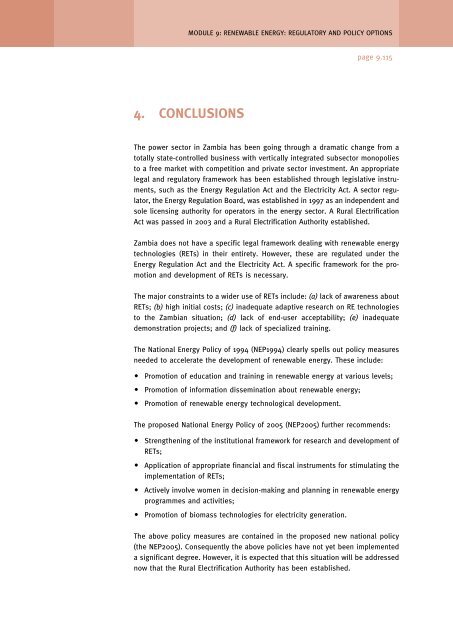Regulatory and policy options to encourage development of ...
Regulatory and policy options to encourage development of ...
Regulatory and policy options to encourage development of ...
- No tags were found...
Create successful ePaper yourself
Turn your PDF publications into a flip-book with our unique Google optimized e-Paper software.
MODULE 9: RENEWABLE ENERGY: REGULATORY AND POLICY OPTIONSpage 9.1154. CONCLUSIONSThe power sec<strong>to</strong>r in Zambia has been going through a dramatic change from a<strong>to</strong>tally state-controlled business with vertically integrated subsec<strong>to</strong>r monopolies<strong>to</strong> a free market with competition <strong>and</strong> private sec<strong>to</strong>r investment. An appropriatelegal <strong>and</strong> regula<strong>to</strong>ry framework has been established through legislative instruments,such as the Energy Regulation Act <strong>and</strong> the Electricity Act. A sec<strong>to</strong>r regula<strong>to</strong>r,the Energy Regulation Board, was established in 1997 as an independent <strong>and</strong>sole licensing authority for opera<strong>to</strong>rs in the energy sec<strong>to</strong>r. A Rural ElectrificationAct was passed in 2003 <strong>and</strong> a Rural Electrification Authority established.Zambia does not have a specific legal framework dealing with renewable energytechnologies (RETs) in their entirety. However, these are regulated under theEnergy Regulation Act <strong>and</strong> the Electricity Act. A specific framework for the promotion<strong>and</strong> <strong>development</strong> <strong>of</strong> RETs is necessary.The major constraints <strong>to</strong> a wider use <strong>of</strong> RETs include: (a) lack <strong>of</strong> awareness aboutRETs; (b) high initial costs; (c) inadequate adaptive research on RE technologies<strong>to</strong> the Zambian situation; (d) lack <strong>of</strong> end-user acceptability; (e) inadequatedemonstration projects; <strong>and</strong> (f) lack <strong>of</strong> specialized training.The National Energy Policy <strong>of</strong> 1994 (NEP1994) clearly spells out <strong>policy</strong> measuresneeded <strong>to</strong> accelerate the <strong>development</strong> <strong>of</strong> renewable energy. These include: Promotion <strong>of</strong> education <strong>and</strong> training in renewable energy at various levels; Promotion <strong>of</strong> information dissemination about renewable energy; Promotion <strong>of</strong> renewable energy technological <strong>development</strong>.The proposed National Energy Policy <strong>of</strong> 2005 (NEP2005) further recommends: Strengthening <strong>of</strong> the institutional framework for research <strong>and</strong> <strong>development</strong> <strong>of</strong>RETs; Application <strong>of</strong> appropriate financial <strong>and</strong> fiscal instruments for stimulating theimplementation <strong>of</strong> RETs; Actively involve women in decision-making <strong>and</strong> planning in renewable energyprogrammes <strong>and</strong> activities; Promotion <strong>of</strong> biomass technologies for electricity generation.The above <strong>policy</strong> measures are contained in the proposed new national <strong>policy</strong>(the NEP2005). Consequently the above policies have not yet been implementeda significant degree. However, it is expected that this situation will be addressednow that the Rural Electrification Authority has been established.










